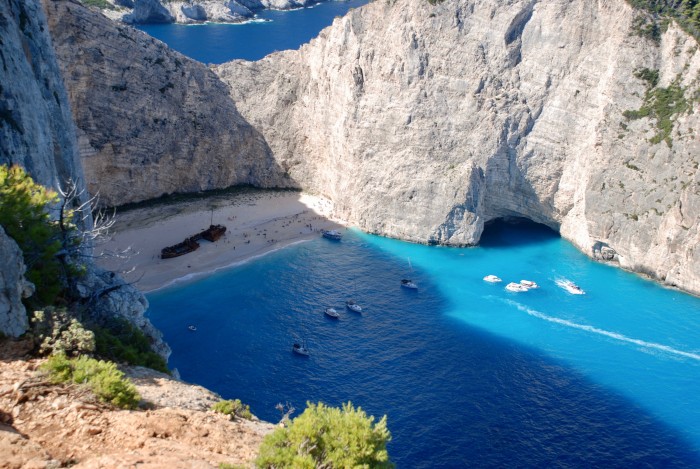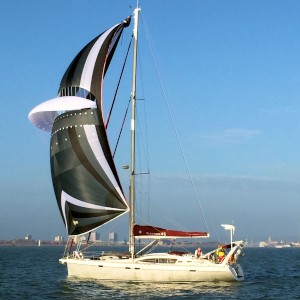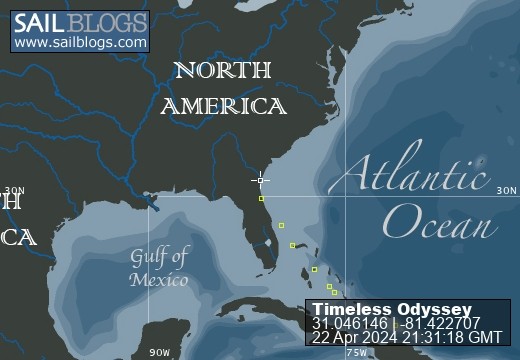Eastern Med Blog 4, The Ionian South of Lefkas canal (June/July 2018)

Since the last blog, we went from Áy Eufimia where we sat out some stormy weather and serious rain for two days and managed to visit the cave lake, Melissani during a break in the weather. From there, we had a short hop to Poros, a small town but a major ferry port for Cephalonia and onward to Zákinthos where we spent 3 nights in Áy Nikólaos, two on the quay and one night at anchor behind the small island in the entrance of the harbour. We hired a scooter one day and did some wonderful exploration ashore testing the climbing abilities of a 125cc scooter, two-up, to the limit. We also did a day going around the northern tip of Cephalonia in the boat, to the blue caves and to visit the world famous and dramatic Shipwreck Beach on the west coast. It was tripper boat mayhem but worth it. After 3 days on Zakinthos we had a wonderful reach back to Poros for a night followed by a stunning night in 3-Goat bay on the southern end of Ithaca. Three goats Actually more), some ruins and nothing else but gin clear water. It was here that the Bulgarians moored next to us invited us onto their charter boat to watch the England soccer world cup game against Colombia. Amazingly, it was streamed on an iPad over 3G with an Austrian sim card. We hardly had a signal on our phones. We spent a night in Big Vathi, the main town on Ithaca and mused that it was a poignant place to visit since it is popularly believed to be the home of Odysseus and Homer. Poignant of course because the boat name is Timeless Odyssey, named when we had no idea we would ever come here. We spend three days on the small islands of Kastos and Kalamos, both stunning, before making our way back to Meganisi and our favourite spot, Karnagio yacht haven close to Small Vathi, for two nights. From here we go back to Preveza for some hard work of preparing the boat for a lift on the morning of the 14th July before flying back the next day.
What I would like to do is leave the rest of this blog post to address, from a purely personal, eyes of this beholder perspective, some observations, idiosyncrasies and musings of our Ionian experience so far. These follow:
Greek Wine: When I was here in the 1980's, Retsina, was about all you could get. The Greeks must have developed some evolutionary quirk that allowed them to drink and even possibly enjoy that stuff. To other mere mortals in life it was like putting a mixture of urine and pine needles into the liquidiser. Even before coming here this time, some of my mates were firing warning shots across our bows about the wine. All these previous perceptions are wrong, Greek wine has come a long way, for €7 to €13 you can get, for example, a bottle of Sauvignon Blanc or Syrah, that will compete with many anywhere in the world. Perhaps the biggest cultural adjustment people need to make, in my opinion, is to the concept of restaurant house wine in a carafe, glistening with condensation. This is excellent value for money and perfectly palatable, often rivalling stuff you would pay €8-ish for in a bottle. When you delve deeper into this, you find it is unashamedly called bulk wine (even on some menus). Once you get past the barrier of your social conditioning and engrained sensibilities, you can cruise into a shop or even some restaurants and fill your own bottle with it.....and it is remarkably good for the price.
Greek Food: As Heikell says in the pilot guide, it is not a culinary destination but I think that is an under-sell. I speak for most of the vegetables here but particularly the tomatoes; they are not the perfect unblemished variety you get in Waitrose. You select them from a crate and they are fresh from somewhere close by. Trust me you can taste the difference. The irony here is these are truly organic and there is no price premium paid for the privilege. Greek salads with chunks of feta are to die for. All you need for breakfast is a proper Greek yogurt, 5 or even 10% fat, creamy and delicious, mix in a few nuts and dried apricots and your day starts in heaven. Tzatziki, why don't we make this at home? Zuchinni balls and cheese balls, delicious. I could go on but the general essence of this is simple food, mostly very healthy, close to the source and moist and tasty, what the climate demands. Complimentary water melon to finish the meal is a feature at many tavernas and restaurants.
Names and Port assistance: I reckon, that if you go into any port in the Ionian, there is a 50% probability that the director of operations and larger than life personality will be called either George, Dimtris, Costos or Konstantinos. Zeus, was the exception for us. They are without exception prone to over-instruction. Barking from the quay, a little bit more, reverse, neutral, throw me the lines, cut cut and tighten the anchor. I mention it because I find it amusing. It is of course, always well meaning and understandable, considering the number of chartering/captain-clueless types there are in these parts. The epitome of the George type, is George at Kalamos. Big restaurant, tiny harbour. He helps you moor, you eat in his restaurant, that is the deal. He packs the boats in, directing, nudging with a RIB and building rafts of yachts until an aerial view of the harbour would have a close resemblance to a freshly opened sardine can. He knows what he is doing but anchors are laid over each other. Ours was way underneath the second row raft of about 20 boats that he built on the opposite side of the harbour. The next day as people are leaving, George is missing. Amazingly of the 60 or so boats in there, I only saw 4 tangled anchors in the morning, all sorted with gentlemanly behaviour.
Ionian people: I was amazed at how many people we came across who had South African connections, their parents or grandparents had gone to South Africa after WWII or after the devastating earthquake in 1953. Now many of the next generation were returning either part time or full time, to manage family properties or to retire. The same story applies to many Greek heritage Australians. In general though the people are helpful, friendly and everything is reasonable. I struggle to describe this but in some of the other countries we have been in the Med, there is a slight edge on things, a slight sense of, I want your money and then you can go. I never got that in Greece.
Sailing and general weather conditions: There are more boats/yachts here and certainly more charter boats than I have seen anywhere else in the Med so far. The sailing conditions are not brilliant because generally there is no wind until 14h00 and then sometimes it can be patchy. We did have quite a few really good sails though. The real reason I think there are so many boats is because of the amount of interesting places to go, all in easy reach of one another, the value for money, the gin clear water, the physical beauty of the place and dramatic landscapes and the welcoming people. We did experience about 10 days of hectic thunderstorms during the 2 months we were in the Ionian but were lucky not to be in the hotspots. People we met and crossed paths with, experienced water spouts and close proximity lightning. We just saw the torrential rain. That said most of the time it was wall to wall blue sky and a day where you wanted to go for a long paddleboard early in the calm and cool of the morning 6am to 7:30am. In the afternoon, you were often just waiting for that moment when the heat starts to turn off, generally after 20h00.
Stand-out places: The bay where the Durrell's lived, the anchorage off the Panorama restaurant near Pitriti, both on Corfu. Lakka and Gious on Paxos. The day anchorage on the north of Anti Paxoxs. Meganisi, any of the bays and the island in general. Ay Nikolaos on Zakinthos and Zakinthos island away from the main towns, especially the view from the top down onto Shipwreck Bay. 3 Goat Bay on the bottom of Ithaca. The islands of Kastos and Kalamos.
All in all a fantastic short season of sailing.
What I would like to do is leave the rest of this blog post to address, from a purely personal, eyes of this beholder perspective, some observations, idiosyncrasies and musings of our Ionian experience so far. These follow:
Greek Wine: When I was here in the 1980's, Retsina, was about all you could get. The Greeks must have developed some evolutionary quirk that allowed them to drink and even possibly enjoy that stuff. To other mere mortals in life it was like putting a mixture of urine and pine needles into the liquidiser. Even before coming here this time, some of my mates were firing warning shots across our bows about the wine. All these previous perceptions are wrong, Greek wine has come a long way, for €7 to €13 you can get, for example, a bottle of Sauvignon Blanc or Syrah, that will compete with many anywhere in the world. Perhaps the biggest cultural adjustment people need to make, in my opinion, is to the concept of restaurant house wine in a carafe, glistening with condensation. This is excellent value for money and perfectly palatable, often rivalling stuff you would pay €8-ish for in a bottle. When you delve deeper into this, you find it is unashamedly called bulk wine (even on some menus). Once you get past the barrier of your social conditioning and engrained sensibilities, you can cruise into a shop or even some restaurants and fill your own bottle with it.....and it is remarkably good for the price.
Greek Food: As Heikell says in the pilot guide, it is not a culinary destination but I think that is an under-sell. I speak for most of the vegetables here but particularly the tomatoes; they are not the perfect unblemished variety you get in Waitrose. You select them from a crate and they are fresh from somewhere close by. Trust me you can taste the difference. The irony here is these are truly organic and there is no price premium paid for the privilege. Greek salads with chunks of feta are to die for. All you need for breakfast is a proper Greek yogurt, 5 or even 10% fat, creamy and delicious, mix in a few nuts and dried apricots and your day starts in heaven. Tzatziki, why don't we make this at home? Zuchinni balls and cheese balls, delicious. I could go on but the general essence of this is simple food, mostly very healthy, close to the source and moist and tasty, what the climate demands. Complimentary water melon to finish the meal is a feature at many tavernas and restaurants.
Names and Port assistance: I reckon, that if you go into any port in the Ionian, there is a 50% probability that the director of operations and larger than life personality will be called either George, Dimtris, Costos or Konstantinos. Zeus, was the exception for us. They are without exception prone to over-instruction. Barking from the quay, a little bit more, reverse, neutral, throw me the lines, cut cut and tighten the anchor. I mention it because I find it amusing. It is of course, always well meaning and understandable, considering the number of chartering/captain-clueless types there are in these parts. The epitome of the George type, is George at Kalamos. Big restaurant, tiny harbour. He helps you moor, you eat in his restaurant, that is the deal. He packs the boats in, directing, nudging with a RIB and building rafts of yachts until an aerial view of the harbour would have a close resemblance to a freshly opened sardine can. He knows what he is doing but anchors are laid over each other. Ours was way underneath the second row raft of about 20 boats that he built on the opposite side of the harbour. The next day as people are leaving, George is missing. Amazingly of the 60 or so boats in there, I only saw 4 tangled anchors in the morning, all sorted with gentlemanly behaviour.
Ionian people: I was amazed at how many people we came across who had South African connections, their parents or grandparents had gone to South Africa after WWII or after the devastating earthquake in 1953. Now many of the next generation were returning either part time or full time, to manage family properties or to retire. The same story applies to many Greek heritage Australians. In general though the people are helpful, friendly and everything is reasonable. I struggle to describe this but in some of the other countries we have been in the Med, there is a slight edge on things, a slight sense of, I want your money and then you can go. I never got that in Greece.
Sailing and general weather conditions: There are more boats/yachts here and certainly more charter boats than I have seen anywhere else in the Med so far. The sailing conditions are not brilliant because generally there is no wind until 14h00 and then sometimes it can be patchy. We did have quite a few really good sails though. The real reason I think there are so many boats is because of the amount of interesting places to go, all in easy reach of one another, the value for money, the gin clear water, the physical beauty of the place and dramatic landscapes and the welcoming people. We did experience about 10 days of hectic thunderstorms during the 2 months we were in the Ionian but were lucky not to be in the hotspots. People we met and crossed paths with, experienced water spouts and close proximity lightning. We just saw the torrential rain. That said most of the time it was wall to wall blue sky and a day where you wanted to go for a long paddleboard early in the calm and cool of the morning 6am to 7:30am. In the afternoon, you were often just waiting for that moment when the heat starts to turn off, generally after 20h00.
Stand-out places: The bay where the Durrell's lived, the anchorage off the Panorama restaurant near Pitriti, both on Corfu. Lakka and Gious on Paxos. The day anchorage on the north of Anti Paxoxs. Meganisi, any of the bays and the island in general. Ay Nikolaos on Zakinthos and Zakinthos island away from the main towns, especially the view from the top down onto Shipwreck Bay. 3 Goat Bay on the bottom of Ithaca. The islands of Kastos and Kalamos.
All in all a fantastic short season of sailing.






Comments